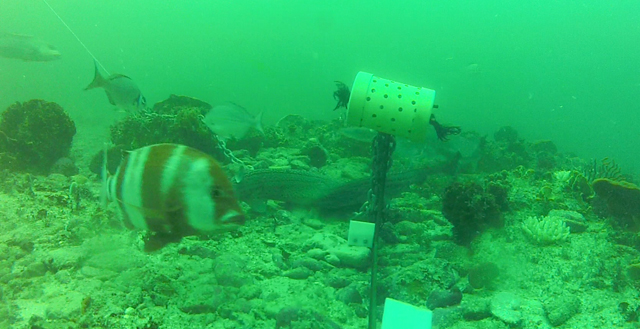Struisbaai’s secrets
I have a bit of a confession to make.
Somewhere, in the midst of nearly 300 hours of footage we’ve collected using our BRUVs to date, I forgot about some hidden gems I’ve been meaning to share for some time! Reasonably forgivable, perhaps, in light of the work that’s been flying our way here in False Bay …
This week alone saw some exciting developments. Our two Masters students, Ralph Watson and Carolyn Sanguinetti, have received their thesis results and can close this rather stressful and exciting chapter of their lives – pretty impressive work for two young people who both managed to flatten MSc coursework and a thesis in only one year! A big WELL DONE to them both – it’s been wonderful having their enthusiasm and insights onboard … and I loved finally having a bit of company on the boat!
We’ve been churning out results from False Bay and I presented the first of these as part of the ongoing “Evolution of BRUVs” story at the recent Shark and Ray Symposium in Mossel Bay. Only two days after the conference, I raced up the coastline again to host the first of our BRUV monitoring workshops (this one for Cape Nature) in the gorgeous Goukamma MPA … but more about that in another blog post …
So, in the midst of hours of analysis, the frantic writing up of publications, presentations and workshops, I rediscovered a little video from our trip to Struisbaai earlier this year.
One of the most important goals for me in this project has been to share, as widely as possible, what we are doing: the scientific developments, the management implications and of course, the sheer enchantment of dipping below the waves … As part of this, Colin and I have been working hard to give incoming cohorts of future marine biologists as much exposure as possible to new field methods.
I can well recall my first undergraduate research camp – and how, after volunteering day-after-day to scrub down the boat after fieldwork (simply to be near to it – deprived landlubber that I was!) I realised that I was in exactly the right field. Giving other students that same chance to discover something life-changing, something worth directing their career towards, has seen me doggedly dragging our BRUV rigs along to our undergraduate research camps this year! We’ve had students on board chopping sardines, scribbling down data and enthusiastically lowering cameras into the sea. We’ve had camp evenings spent reviewing exciting new footage. There’s nothing quite like setting up the projector I’d brought along (balanced precariously on a pile of well-thumbed fish field guides, of course) to marvel at the sights we’d filmed that day. I challenge anyone to suppress a smile when the students shriek delightedly as a whole new world is projected onto the walls of our camp accommodation whilst the canp fires flicker outside …

Blurred diversity: a red stumpnose, a red steenbras and smooth-hound shark amongst the catsharks, fransmadam and steentjies
It was in Struisbaai that we filmed the two beautiful great white sharks that I posted about in an earlier blog (and you can only imagine the reaction from students and staff alike!), but I’m a bit of a softie when it comes to some of the less “obviously” charismatic finds … I was personally thrilled to have such clear footage of red stumpnose – and who can resist watching a bit of a tussle between two huge short-tailed rays?
Plug in some headphones and take a dive!
https://vimeo.com/66306384

